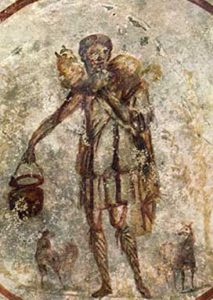The Christian catacombs of Rome are underground burial places dating from the first four centuries A.D. In addition to the remains of early Christians, the catacombs contained numerous wall paintings (frescos) and sculpture which have long been a source of fascination to the art world and historians as they comprise the vast majority of extant Christian art from the Roman Empire era. Philip Schaff, author of the eight-volume History of the Christian Church writes of the catacombs:
Their most characteristic symbols and pictures are the Good Shepherd, the Fish, and the Vine. These symbols almost wholly disappeared after the fourth century, but to the mind of the early Christians they vividly expressed, in childlike simplicity, what is essential to Christians of all creeds, the idea of Christ and his salvation, as the only comfort in life and in death. The Shepherd, whether from the Sabine or the Galilean hills, suggested the recovery of the lost sheep, the tender care and protection, the green pasture and fresh fountain, the sacrifice of life: in a word, the whole picture of a Saviour.[1]

Fresco example from the Roman Catacombs
Schaff also quotes from A.P. Stanley’s Lectures on the History of the Eastern Church:
What was the popular Religion of the first Christians? It was, in one word, the Religion of the Good Shepherd. The kindness, the courage, the grace, the love, the beauty of the Good Shepherd was to them, if we may so say, Prayer Book and Articles, Creeds and Canons, all in one.[2]
Finally, in his study of Christ’s parables Richard Trench writes: “On no image does the early Church seem to have dwelt with greater delight than this of Christ as the good Shepherd bringing home his lost sheep.”[3]
What does scripture have to say about this? We know there are many representations of Christ through scripture: the King of all kings, the Lion of the tribe of Judah (yet also the Lamb of God), the suffering servant, and the true personification of light and life are just some of the examples which convey to us the breadth of Jesus’ ministry to his people. As common and important as any is the picture we see repeatedly through 1000 years of scripture of Jesus, the Messiah, as Shepherd. All considered, it is no surprise of the enduring affection for, and comfort from, the much beloved Psalm 23. Pastor Andrew introduced our four part series, The Lord, My Shepherd, last Sunday. On our remaining Sundays I will be looking at three primary characteristics of the Lord’s shepherding of our lives: He is our leader, our protector, and our provider. I know you will be encouraged and edified as we consider these wonderful truths of the object of our Christian faith, the Good Shepherd Jesus!
Much love,
~ Pastor Gary
[1] Philip Scaff, History of the Christian Church, (reprinted, Peabody, MA: Hendrickson, 2002), 2:308
[2] Arthur P. Stanley, “Study of Ecclesiastical History” in Lectures on the History of the Eastern Church, p283 (quoted by Schaff, 2:308)
[3] Richard C. Trench, Notes on the Parables of Our Lord, 7th ed. (London: John W. Parker, 1857), p380

As we gather for Sunday worship, we want you to meet with God and be transformed by the Word. Prepare your heart by reading the passage and listening to the songs for Sunday.
